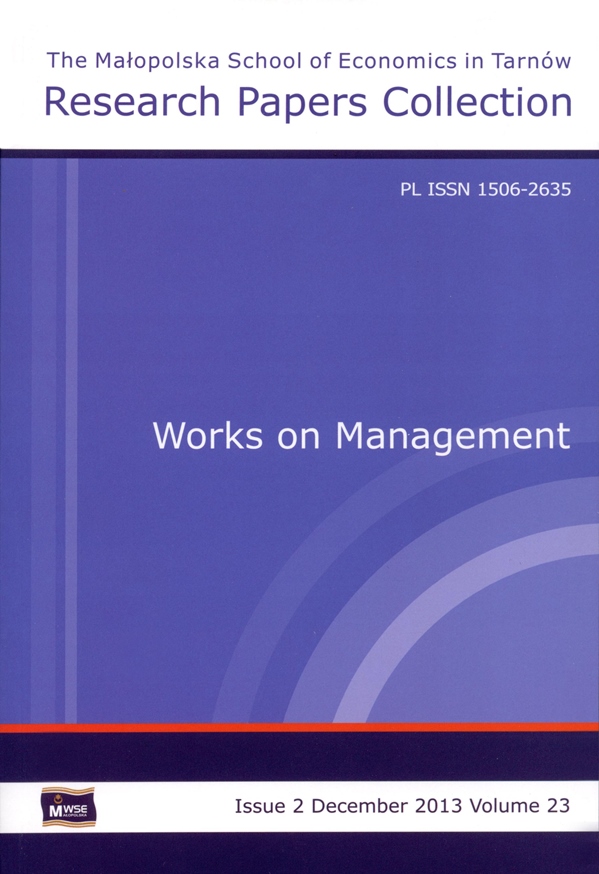Abstract
The purpose of this article is to show the relationship between the use, by the company, of specific method of acquiring knowledge from the outside, the formation of mutually beneficial relationships with customers (relationship marketing), and their realization of the innovation process. The idea of relationship marketing and Customer Relationship Management system (CRM) is to build long-term relationships with the environment, in particular with customers, in order to increase the profitability of the company as well as cost reduction. Relationships with customers (more CRM) are an effective tool for gathering information for the innovation process, both at the stage of invention innovation (increase the innovative capacity of the organization) and at the stage of diffusion of innovation (innovative activity). The condition for the effectiveness of personalized marketing include: close contact with the customer, control, and continuous analysis of their course as well as information technology and databases. The results of extensive empirical studies allowed for positive verification of the given argument. The use of customer relations is beneficial to the process of innovation, and ultimately leads to offer customers innovative product tailored to your expectations. Companies are aware of the fact that customers are an important source of knowledge in the innovation process, and the human factor plays a leading role in creating innovation. The focus on relationships with customers is especially important for small and medium-sized businesses that have limited financial resources (inter alia in the area of conducting research) in terms of identifying new and costly innovative solutions.
References
Aghion Ph., Hemous D., Kharroubi E. Credit constraints, cyclical fiscal policy and industry growth [online, accessed: 2013-03-28]. National Bureau of Economic Research 2009. Available online: http://discovery.ucl.ac.uk/17759/1/17759.pdf (Working Paper, no. 15119).
View in Google Scholar
Chesbrough H. Open innovation: The new imperative for creating and profiting from technology. Boston: Harvard Business School Press, 2003. ISBN 1-57851-837-7.
View in Google Scholar
Dobiegała-Korona B. “Strategie innowacji w budowie kapitału klienta”. In: Zarządzanie wartością klienta. Pomiar i strategie. Ed. B. Dobiegała-Korona, R. Doligalski. Warszawa: Poltext, 2010. ISBN 978-83-7561-058-1.
View in Google Scholar
Drucker P.F. Zarządzanie organizacją pozarządową. Teoria i praktyka. Transl. by M. Wanat. Warszawa: Fundusz Współpracy; Program Phare Dialog Społeczny NGOs, 1995. ISBN 83-904247-3-8.
View in Google Scholar
Fagerberg J. “The dynamics of technology, growth and trade: A Schumpeterian perspective”. In: Elgar companion to neo-Schumpeterian economics. Ed. H. Hanusch, A. Pyka. Cheltenham: Edward Elgar, 2007. ISBN 978-1-84376-253-9.
View in Google Scholar
Forsman H. “Business development success in SMEs: A case study approach”. Journal of Small Business and Enterprise Development, 2008, nr 15 (3), pp. 606–622.
View in Google Scholar
Furman J.L., Porter M.E., Stern S. “The determinants of national innovative capacity”. Research Policy, 2002, no. 31, pp. 899–933.
View in Google Scholar
Hall C.M., Williams A.M. Tourism and innovation, New York: Routledge, 2008. ISBN 978-0-415-41404-3.
View in Google Scholar
Hirsch-Kreinsen H. “Low-tech innovations”. Industry and Innovation, 2008, vol. 15, iss. 1, pp. 19–43.
View in Google Scholar
Hurmelinna-Laukkanen P.L., Sainio M., Jauhiainen T. “Appropriability regime for radical and incremental innovations”. R&D Management, 2008, vol. 38, iss. 3.
View in Google Scholar
INSEAD. Global Innovation Index: More on methodology, INSEAD Global Innovation Index, 2007.
View in Google Scholar
Martin R. “The age of customer capitalism”. Harvard Business Review, 2010, vol. 88, iss. 1, pp. 58–66.
View in Google Scholar
Mikuła B. Organizacje oparte na wiedzy. Kraków: Wydawnictwo Akademii Ekonomicznej w Krakowie, 2006. ISBN 83-7252-302-9.
View in Google Scholar
Romjin H., Albaladejo M. Determinants of innovation capability in small UK firms. An empirical analysis. Oxford: University of Oxford Press, 2000 (Queen Elizabeth House Working Paper Series, Working Paper, no. 40).
View in Google Scholar
Santamaría L., Nieto M.J., Barge-Gil A. “Beyond formal R&D: Taking advantage of other sources of innovation in low- and medium-technology industries”. Research Policy, 2009, vol. 38, iss. 3, pp. 507–517.
View in Google Scholar
Schumpeter J. A. Teoria rozwoju gospodarczego. Transl. by J. Grzywicka. Warszawa: PWN, 1960.
View in Google Scholar
Wysokińska-Senkus A. Doskonalenie systemowego zarządzania w kontekście sustainability. Warszawa: Difin, 2013. ISBN 978-83-7641-906-0.
View in Google Scholar
© Copyright by Małopolska School of Economics in Tarnów. The articles are available under the Creative Commons Attribution NonCommercial-NoDerivatives 4.0 International License


